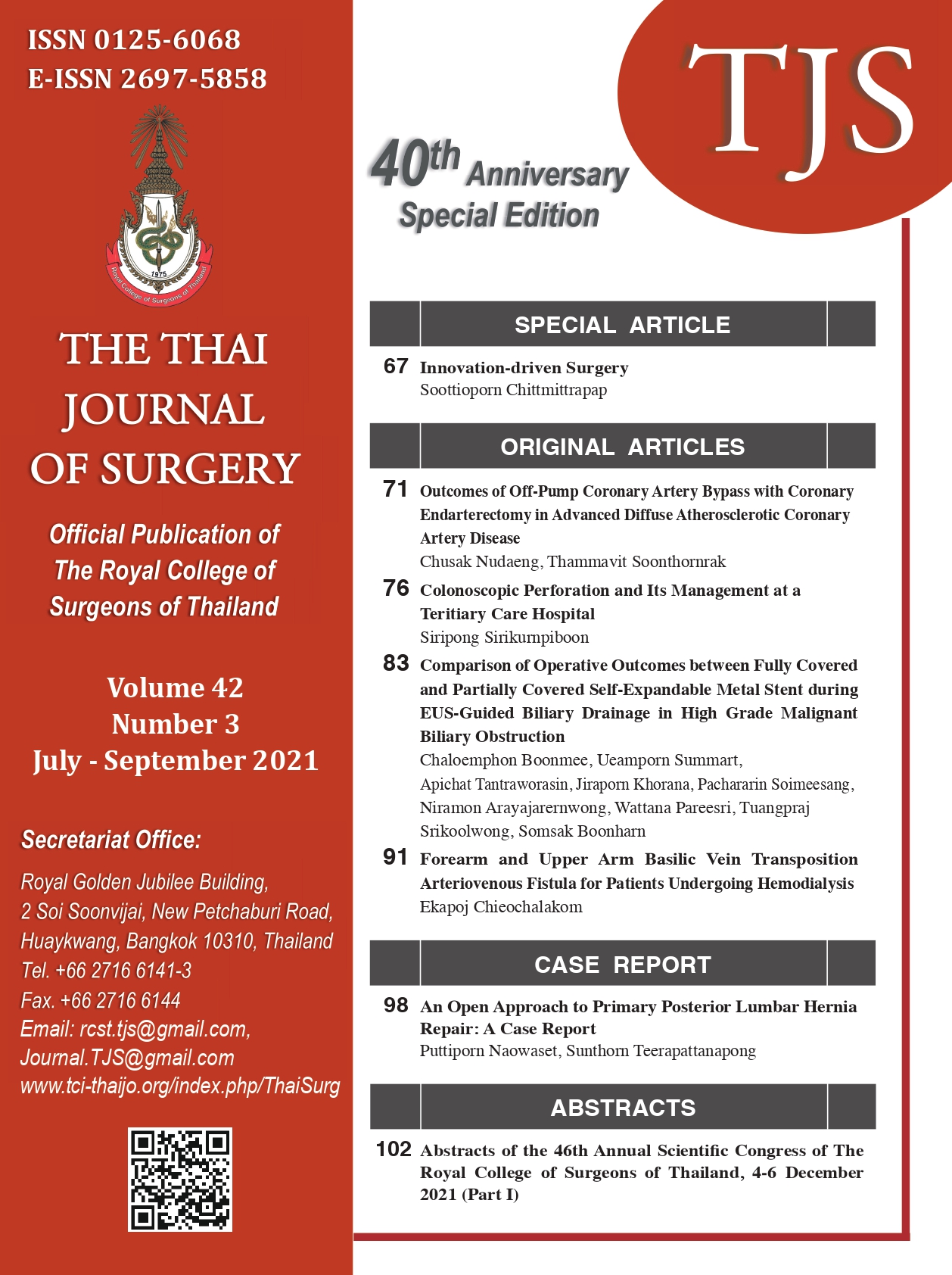Comparison of Operative Outcomes between Fully Covered and Partially Covered Self-Expandable Metal Stent during EUS-Guided Biliary Drainage in High Grade Malignant Biliary Obstruction
Keywords:
Endoscopic ultrasound, EUS-BD, High grade malignant biliary obstruction, EUS stent, Operative outcomesAbstract
Introduction & Objective: EUS-guided biliary drainage (EUS-BD) has been increasingly used for the management of high grade malignant biliary obstruction (HGMBO). Nevertheless, the type of stent that is most suitable for EUS-BD remains controversial. The aim of the present study was to compare operative outcomes between fully covered self-expandable metal stent (FCSEMS) and partially covered self-expandable metal stent (PCSEMS) in HGMBO patients.
Methods: The present retrospective cohort study included HGMBO patients who underwent EUS-BD between April 2017 and August 2020. The endpoints were operative outcomes after stent placement. Two-step analysis was performed. Logistic regression was used to calculate a propensity score (PS). Multi-level mixed model stratified by PS were used for comparing the primary and secondary outcomes between groups and are presented in term of adjusted RR, mean difference, hazard ratios and their 95% confidence intervals.
Results: There were 53 patients in the study, 41 in the PCSEMS group and 12 in the FCSEMS group. Baseline characteristics were not statistically different. After adjusting for PS, by using the PCSEMS group as the reference, there were no statistically significant differences in the outcomes between PCSEMS and FCSEMS. These include technical success rates (both 100%), clinical success rates (89% vs. 67%; p = 0.489), early and late complications (5% vs 8%; p = 0.493 and 50% vs. 92%; p = 0.110, respectively). Moreover, overall deaths were not significant different (83% vs. 100%; p = 0.971).
Conclusions: FCSEMS and PCSEMS in HGMBO were comparable in terms of technical and clinical success. However, PCSEMS patients were less likely to die or have late complications.
References
Makmun D, Fauzi A, Abdullah M, Syam AF. The role of EUS-BD in the management of malignant biliary obstruction: The Indonesian Perspective. Diagn Ther Endosc 2017;2017:4856276. doi:10.1155/2017/4856276.
Guo J, Giovannini M, Sahai AV, et al. A multi-institution consensus on how to perform EUS-guided biliary drainage for malignant biliary obstruction. Endosc Ultrasound 2018;7:356-65.
Kakked G, Salameh H, Cheesman AR, et al. Primary EUS-guided biliary drainage versus ERCP drainage for the management of malignant biliary obstruction: A systematic review and meta-analysis. Endosc Ultrasound 2020;9:298-307.
Sangchan A, Kongkasame W, Pugkhem A, et al. Efficacy of metal and plastic stents in unresectable complex hilar cholangiocarcinoma: a randomized controlled trial. Gastrointest Endosc 2012;76:93-9.
Hathorn KE, Bazarbashi AN, Sack JS, et al. EUS-guided biliary drainage is equivalent to ERCP for primary treatment of malignant distal biliary obstruction: a systematic review and meta-analysis. Endosc Int Open 2019;7:E1432-41.
Shin HC, Cho CM, Jung MK, Yeo SJ. Comparison of clinical outcomes between plastic stent and novel lumen-apposing metal stent for endoscopic ultrasound-guided drainage of peripancreatic fluid collections. Clin Endosc 2019;52:353-9.
Yamao K, Sawaki A, Takahashi K, et al. EUS-guided choledochoduodenostomy for palliative biliary drainage in case of papillary obstruction: report of 2 cases. Gastrointest Endosc 2006;64:663-7.
Yamao K, Bhatia V, Mizuno N, et al. EUS-guided choledochoduodenostomy for palliative biliary drainage in patients with malignant biliary obstruction: results of long-term follow-up. Endoscopy 2008;40:340-2.
Park DH, Kim MH, Moon SH, et al. Feasibility and safety of placement of a newly designed, fully covered self-expandable metal stent for refractory benign pancreatic ductal strictures: a pilot study (with video). Gastrointest Endosc 2008;68:1182-9.
Kim TH, Kim SH, Oh HJ, et al. Endoscopic ultrasound-guided biliary drainage with placement of a fully covered metal stent for malignant biliary obstruction. World J Gastroenterol 2012;18:2526-32.
Nakai Y, Sato T, Hakuta R, et al. Long-term outcomes of a long, partially covered metal stent for EUS-guided hepaticogastrostomy in patients with malignant biliary obstruction (with video). Gastrointest Endosc 2020;92:623-31.e1.
van der Gaag NA, Rauws EA, van Eijck CH, et al. Preoperative biliary drainage for cancer of the head of the pancreas. The N Engl J Med 2010;362:129-37.
Giovannini M, Moutardier V, Pesenti C, et al. Endoscopic ultrasound-guided bilioduodenal anastomosis: a new technique for biliary drainage. Endoscopy 2001;33:898-900.
Püspök A, Lomoschitz F, Dejaco C, et al. Endoscopic ultrasound guided therapy of benign and malignant biliary obstruction: a case series. Am J Gastroenterol 2005;100:1743-7.
Itoi T, Itokawa F, Sofuni A, et al. Endoscopic ultrasound-guided choledochoduodenostomy in patients with failed endoscopic retrograde cholangiopancreatography. World J Gastroenterol 2008;14:6078-82.
Downloads
Published
How to Cite
Issue
Section
License
Articles must be contributed solely to The Thai Journal of Surgery and when published become the property of the Royal College of Surgeons of Thailand. The Royal College of Surgeons of Thailand reserves copyright on all published materials and such materials may not be reproduced in any form without the written permission.



